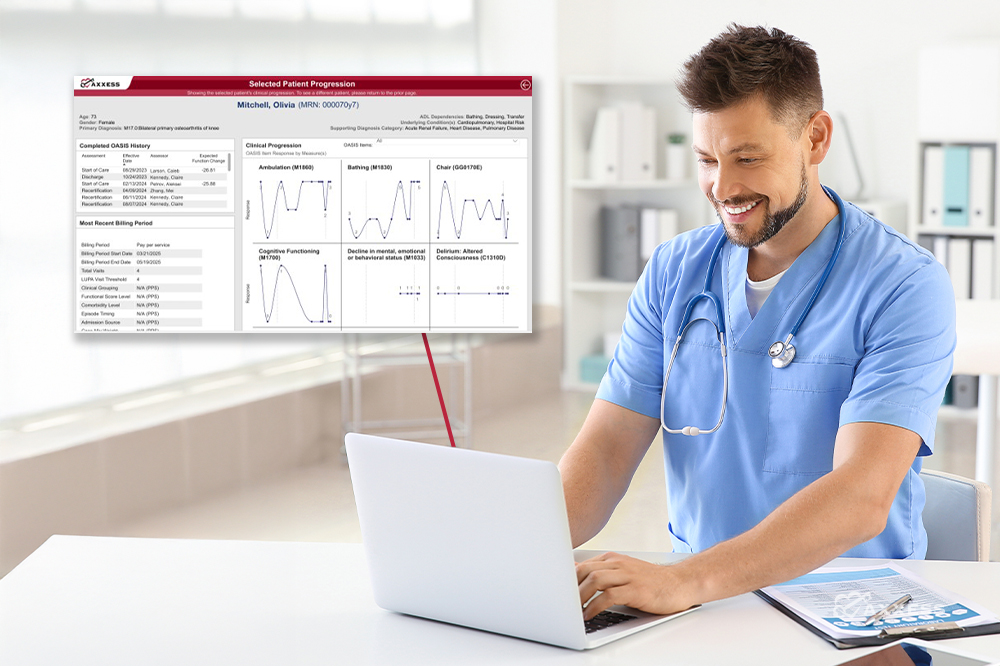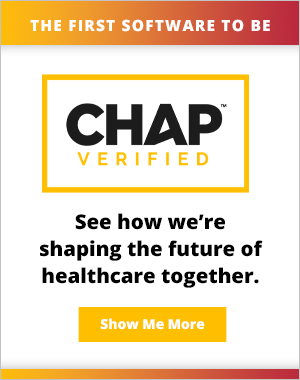
At the 2025 Axxess Growth, Innovation, and Leadership Experience (AGILE), product leaders showcased several new innovations that are now available to organizations. One of the features unveiled was the Care Predictor, the latest, innovative Axxess Business Intelligence tool.
Jaime Carlson, Senior Vice President of Business Intelligence, announced the Care Predictor during AGILE and shared more information about the features and ways in which it helps organizations deliver more patient-centered care.
The Care Predictor
Powered by Axxess intelligence™, the Care Predictor enables home health organizations to identify patients who may be eligible for hospice or palliative care much earlier. By leveraging predictive analytics, this tool enables organizations to implement early interventions for at-risk patients.
“This is really our first foray into using AI [artificial intelligence] for predictive analytics and an algorithm to analyze home health patients and flag them as potentially eligible for hospice or palliative care services,” Carlson said.
Carlson explained that the Care Predictor dashboard improves the clinical decision-making process, enabling organizations to make strategic decisions and enhance patient care, ensuring that the patient is on the right care plan.
“If they’re on home health and need to be on palliative or hospice care, we want to be sure that they’re getting the right care at the right service level, at the right time,” Carlson said.
Value-Based Purchasing and Quality Scores
The features of the Care Predictor help organizations reduce hospitalizations and improve quality scores, enhancing their value-based purchasing (VBP) performance while also saving time and money.
“Patients identified by predictive care tools such as the Care Predictor, are often those showing signs of clinical decline,” Carlson said. “While transitioning to hospice remains the patient’s choice—and not all may be ready, recognizing their higher acuity needs enables care teams to proactively adjust the plan of care. This approach helps prevent unnecessary hospitalizations and emergency room visits, which are key drivers in improving VBP scores.”
Reducing acute care utilization delivers the single greatest impact on VBP performance. Additionally, by focusing on individualized care for these high-need patients, organizations not only improve outcomes but also enhance patient satisfaction, another critical measure within VBP.
Carlson notes meeting patients where they are with tailored support leads to better experiences and stronger VBP results.
Partnerships
For organizations that do not have an in-house hospice or palliative care program, predictive tools like the Care Predictor offer a valuable opportunity to identify potential community partners. By recognizing patients who may benefit from end-of-life or advanced illness care, organizations can establish collaborative relationships with local hospice and palliative service providers.
These partnerships not only ensure patients receive appropriate support along the care continuum but also create reciprocal referral opportunities, often leading to increased future referrals to home health services. Ultimately, by building strong community alliances, healthcare organizations can enhance continuity of care, improve patient outcomes and strengthen their role within the broader healthcare ecosystem.
“The dashboard works with external support groups or other referral sources,” Carlson said “So, not just enterprise organizations that have home health and hospice, moving them from one location to another. If you don’t have a hospice program but you’re a home health organization, you can really improve your relationship with referral sources and hopefully end up driving additional revenue.”
In summary, Carlson stated that the Care Predictor provides a wealth of clinical performance metrics at the fingertips of clinical leaders, saving countless hours otherwise spent combing through clinical documentation. With the added benefit of clinical assist support, organizations are empowered to improve and enhance the quality of care for patients throughout their healthcare journey.
“This puts all that documentation into one dashboard where they can really home in on and start to answer the question of is this patient in the right level of care right now,” Carlson said. “It’s all at your fingertips.”
With more than 550 attendees, more than 50 sponsors and countless connections made, AGILE 2025 was a massive success for everyone. Click here to register for AGILE 2026, May 4-6 in Dallas.
